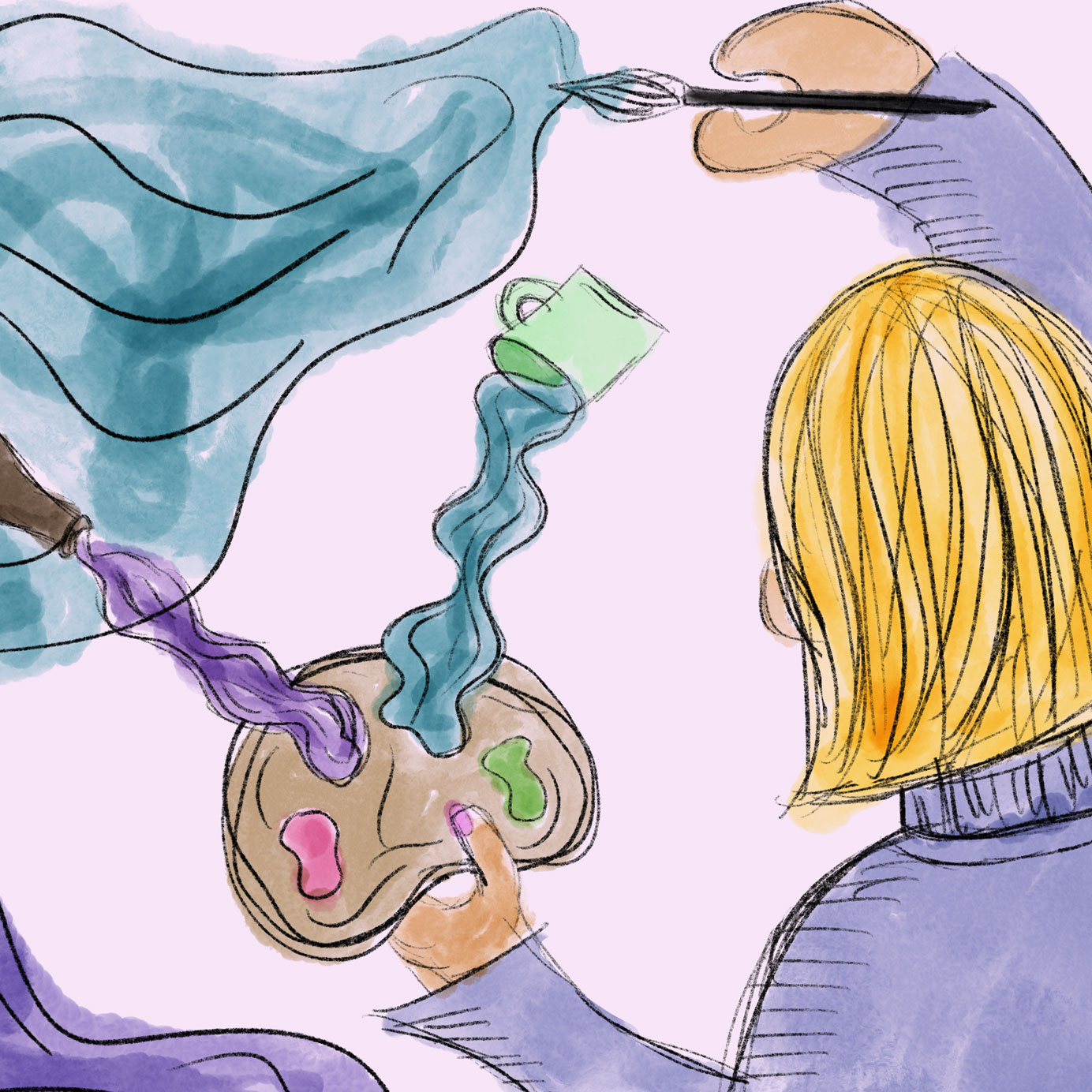
“It was kind of a weird accident,” Kyle Bice, an illustrator and painter, says of his penchant for painting with craft stouts. Beers and bars have been frequent subjects for painters throughout history, but Bice is one of several contemporary artists using beer, wine, coffee, and other drinks as their “paints.” They create beautiful artwork out of substances that most folks sip or gulp.
Bice started working with beer after discovering he had showed up without his paints at a regular meet-up for artists in a Chicago pub. “I always carry this tiny little watercolor brush in my bag,” he says. “I’m a big stout drinker, and I said, ‘Well, let’s try this and see how it goes.’”
It went well enough for Bice to reach out to the craft brewery New Holland, for which he’d done several label illustrations using traditional media. After seeing the work he’d done with New Holland’s flagship imperial stout, Dragon’s Milk, the brewery asked Bice to paint with the beer at a series of promotional events, bringing the idea of drinks-based painting to a wider audience.
https://www.instagram.com/p/BdL9BUajhht/
Painting with drinks seems to capture a good amount of attention. Instagram offers thousands of images with hashtags like #coffeepainting and #winepainting, ranging from the artist Olga Shishunova in Ukraine to Alex Souto in Brazil.
“My first experiences were a lot of fun, just to see how surprised people were when they learned that I was painting with beer,” Souto writes in an email. “I always tried to use as many different techniques as possible with watercolor painting, and in my recent experiences I included coffee, beer and wine.”
In Bend, Ore., the artist Karen Eland has made a career out of painting with the signature beverage of one of America’s best cities for beer. She got started by painting with coffee.
“I was sitting in a coffee shop, and the guy just happened to be pouring an espresso, and I just thought ‘That’s a really pretty color,’” Eland says. “I tried painting with espresso, and then I tried painting with coffee grounds, and then I went back to the espresso and it just kind of took off.”
After that, Eland expanded into beer. At this point she has completed more than 200 beer paintings, while continuing with coffee. Stouts and espresso might look similar on paper, she says, but there is one crucial difference.
“Sometimes I can’t even tell them apart when I finish them, at least until I smell them,” she says. “The coffee ones smell really good, like coffee. But the beer ones smell like old beer.”
Another difference, Eland says, is a glossy appearance. Beer paintings finish stickier than other liquids, and they are usually very shiny when dry.
https://www.instagram.com/p/BrB57WHBfUC/
If you want to try painting with drinks yourself, artists recommend using the darkest beverages you can find. (pilsners, Chardonnays, and hefeweizens are unlikely to work.) And, Souto notes, it will help to use something you enjoy.
“You have to like beer to paint with it,” Souto wrote. “If you do not like the smell, you certainly will not like painting with beer.”
Another tip, Souto suggests, is to paint with a drink at a warmer temperature than one you’d sip. Between 50 and 55 degrees might be the ideal temperature for drinking an imperial stout, but, for painting, something closer to room temperature will help with evaporation.
Since beer and coffee are liquids, not paints, giving each layer time to dry is important, Bice says. “You have to let it dry completely or it’ll pull back off the page.”
To that effect, some artists use a hair dryer in the studio. Otherwise, it just takes a lot of time.
“It’s similar to watercolor, but with watercolor, when you put a layer down it will stay there when you go back over it,” Eland says. “But if you paint with beer and coffee, the layer you paint will kind of come off when you put another layer over it. You have to be real careful when you put it on there, because you’ll just push around the layer you just painted.”
The end result can create a number of blemishes and unexpected effects, which both Eland and Brice note have the potential to create happy accidents.
“The paper doesn’t wholly absorb the drink, so when it dries, you get these weird blobs of color that just settle in weird areas,” Brice says. “They look like mistakes, and I like to go back over therm and manipulate the edges and maybe lighten the edges with a little bit of water, and move the color around until it looks the way I like it.”
Eland notes that painters use these mistakes to their advantage. “Once you know what you’re doing, you can make little snowflakes or other patterns out of it,” she says.
https://www.instagram.com/p/Br6KYnrg4Nj/
While beer and coffee seem to be the favorite beverages of many painters, it seems that just about anything with enough color will work.
“I recently did a few paintings with a dark, fruity mead, and they turned out really well,” Bice says. “I was painting with Breakfast Magpie from New Day Craft, out of Indianapolis. The mead itself is made of coffee and blackberry or raspberry, I’m not sure, and it has this intense maroon or even Merlot color to it.”
Though the artworks can be truly beautiful, it’s the whimsical nature of painting with drinks that seems to hold much of the appeal, much like the experimental, happy-go-lucky nature of many craft beverages. When asked about tips for beginners, Bice offered a final bit of advice that sounded a lot like a classic homebrewing mantra.
“Don’t be afraid to screw up,” he says. “Go and have fun with it.”
